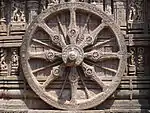Forests in Odisha
Odisha, one of the 29 States of India, has two basic kinds of forest: in the northeast region of the state the forest is classified as the tropical-moist-deciduous type, blanketing hills, plateaus and other high-altitude isolated areas; in the southwest the tropical-dry-deciduous variety dominate.


Forests
Orissa's forests are vast. Out of the total geographical area of 155,707 km2, the State records 52,472 km2 (~33%) as some version of forest. The actual forest cover may be less, according to the Forest Survey of India, rosewood, sal, piasal, teak and haldi. The forest's naturally vigorous growth accounts for a tremendous wealth of biodiversity, filling many catalogues of the wild plant and animal species dwelling within.
The state has declared large parcels of land as protected areas with the purpose being to allow animals and plants who are sensitive to cohabitation with humans places of relative freedom from interference and habitat loss. These protected areas constitute 10.37% of the total forest area and 4.1% of the total geographical area of the state.
Forest flora
The state is home of ca 3000 plant species including 120 orchid species and 63 varieties of mangrove trees which make the state second largest mangrove ecosystem in India.[1]
A vast variety of other plants are also found in the state, as in the following:
- Acorous calamus
- Aegiceras corniculatus
- Alpinia galanga - greater galingal
- Androgaphis paniculata
- Asparagus racemosus - shatavari
- Cathraranthus roseus
- Celastrus paniculatus
- Centella asiatica
- Cissus quadranggularis
- Clerodendrum ssp.
- Colchicum autumnale - autumn crocus
- Commiphora wightii - Mukul myrrh
- Croton roxburghjii
- Curcuma angustifolia
- Digitalis purpurea - common foxglove
- Diogenin
- Emetin
- Ephedra ssp.
- Erythroxylon coca - coca
- Excoecaria agallochi
- Gloriosa superba
- Gugulipid
- Hemidesmus indicus
- Ocimum basilicum
- Plumbago zeylanica
- Pongamia pinnata
- Rauvolfia serpentina - Indian snakeroot
- Salvadora persica
- seagrass
- Taxus brevifolia - Pacific yew
- Toddalia asiatica
- Vinblastim areteminsinine
- Whighina somenifera
Forest fauna
The IUCN Red List has recorded a total of 473 species of birds and 86 species of mammals, 19 species of amphibians and 110 species of reptiles including three crocodilian species. Out of these around 54 species are considered endangered. Home to a variety of wild animals, the state has declared considerable tracts of land as areas protected for these animals only. These protected areas constitute 10.37% of the total forest area and 4.1% of the total geographical area of the state. Not only this, the state also has the distinction of possessing three mass nesting beaches of endangered olive ridley sea turtles which makes it the largest nesting ground of the species.
The state has three mass nesting beaches of endangered olive ridley sea turtles which when combined together makes it the world's largest nesting ground for this species.[2]
Indenting Orissa's ocean coast is Chilika lagoon, a semi-saline wetland used by many species of migratory birds, and also which the endangered Irrawaddy dolphin uses as part of its range. In spite of considerable human interactivity here, the rare dolphin survives. The Orissa government is conducting various programs to protect the species.[3]
Other animals that call Orissa home, or part-time home are listed below.
Land animals
Avians
- Alexandrine parakeets
- Asiatic dowitchers
- Avocets
- Black-headed ibis
- Brahminy ducks
- Brahminy kites
- Collared pratincoles
- Coots
- Dalmatian pelicans
- Dunlins
- Egrets
- Gadwalls
- Geese
- Godwits
- Goliath herons
- Greater flamingos
- Grey herons
- Grey hornbills ~ Ocyceros
- Gull-billed terns ~ Gelochelidon nilotica
- Hill mynas ~ Gracula religiosa
- Indian pied hornbills ~ Anthracoceros coronatus
- Indian trogons ~ Harpactes fasciatus
- Jacanas
- Jungle fowls
- Kestrels
- Kingfishers
- Lapwings
- Larks
- Lesser flamingos
- Little cormorants
- Malabar pied hornbills
- Marsh harriers
- Moorhens
- Night herons
- Pallas's fish-eagles
- Pariah kites
- Peacocks
- Peafowls
- Peregrine falcons
- Pintailss
- Plovers
- Pochards
- Pond herons
- Purple herons
- Red jungle fowls
- River terns
- Rollers
- Ruffs
- Sandpipers
- Shovellers
- Snipes
- Spoonbills
- Spoon-billed sandpipers ~ Eurynorhynchus pygmeus
- Spot-billed pelicans
- Stilts
- Storks
- Teals
- Wagtails
- White-bellied sea eagles
- Wild ducks
References
- "Archived copy" (PDF). Archived from the original (PDF) on 2009-03-26. Retrieved 2009-08-10.CS1 maint: archived copy as title (link)
- "MTN 87:9-10 Fidelity of Male Olive Ridley Sea Turtles to a Breeding Ground". www.seaturtle.org.
- "Archived copy" (PDF). Archived from the original (PDF) on 2009-03-19. Retrieved 2008-12-21.CS1 maint: archived copy as title (link)
